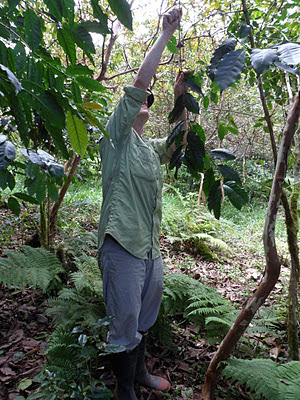This week we will be discussing the coffee production process at Hacienda Tranquila and the steps volunteers go through from picking the beans to brewing the coffee. Anyone who has experienced a fresh cup of coffee at the Hacienda can certainly agree with the fact that the hard work brings a great reward. Your dirty fingernails from peeling the fruit and sore muscles from grinding the beans melt away with that first sip of 100% organic coffee. Volunteers always look forward to days that involve one of the steps in the coffee production because it means we have a fresh supply of coffee beans ready to go at a moment's notice!
Here’s the whole process from start to finish:
Step One: Collecting the Cherries
In the Hacienda’s coffee plantation, volunteers will harvest the coffee beans periodically when the trees are filled with coffee cherries. They are ready for picking when they appear bright red, glossy, and firm. Under-ripe cherries are hard and green, and over-ripe cherries have a dark and shriveled appearance.
In the Hacienda’s coffee plantation, volunteers will harvest the coffee beans periodically when the trees are filled with coffee cherries. They are ready for picking when they appear bright red, glossy, and firm. Under-ripe cherries are hard and green, and over-ripe cherries have a dark and shriveled appearance.
 |
| One of our volunteers picking the coffee cherries. |
Step Two: Peeling the Fruit
Once the fruit is collected, volunteers will peel the thick outer layer of skin and remove the coffee beans. Under the fruit layer is the parchment, which is covered by a thin, slippery layer called mucilage. After removing the parchment, there are two translucent bluish-green coffee beans, which are coated within a thin layer called the silver skin.
 |
| The outer layer is removed to get the coffee beans. |
Step Three: Drying the Beans
In the drying process, ripe cherries are dried in the sun and generally take about two weeks to completely dry. Throughout the drying, cherries must be raked frequently while drying to avoid mildew.
 |
| Spreading the beans out in the sun will allow them to completely dry. |
Step Four: Grinding the Beans
When the beans are fully dried, the last layer of dry skin and remaining fruit residue is removed through the grinding of a simple millstone in a process called hulling.
Step Five: Roasting the Beans
This step in the process produces the characteristic flavor of coffee by forcing the green coffee beans to expand and change in color, taste, and smell. Roasting at the Hacienda is done in a pan over a fire, and the beans will darken the longer they heat.
 |
| Roasting the beans over the fire. |
Step Six: Grinding Fresh Coffee
Prior to brewing, volunteers will grind the roasted coffee beans using the simple millstone. The process is then complete, and fresh ground coffee is ready to be enjoyed!
Unlike traditional coffee production, our process involves zero carbon dioxide emissions because everything is done by hand including the transport of coffee cherries and the grinding of the beans. We rely solely on the hard work of our dedicated volunteers to produce the coffee. In the future, we plan on expanding the size of our coffee plantation to create a larger supply for use within the local community.
We can't wait to share a fresh cup of Hacienda Tranquila's 100% organic coffee with you!
Cheers,
Hacienda Tranquila
 |
| Delicious, organic coffee ready for brewing. |
Unlike traditional coffee production, our process involves zero carbon dioxide emissions because everything is done by hand including the transport of coffee cherries and the grinding of the beans. We rely solely on the hard work of our dedicated volunteers to produce the coffee. In the future, we plan on expanding the size of our coffee plantation to create a larger supply for use within the local community.
We can't wait to share a fresh cup of Hacienda Tranquila's 100% organic coffee with you!
Cheers,
Hacienda Tranquila

No comments:
Post a Comment